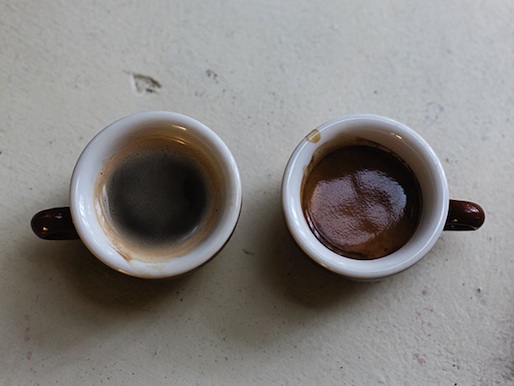Cognition of coffee composition.-Why is there caffeic acid? good caffeic acid?

Professional coffee knowledge exchange More coffee bean information Please pay attention to coffee workshop (Weixin Official Accounts cafe_style)
The first: the fruit has acid, it is fruit acid. The normal fruit acid must be immediately removed from the mouth, the acid must be round, and the acid must bring out the sweetness and turn out the sweet taste. Fruit acid is mature, fruit acid to have a sense of salivation, salivation has thirst-quenching effect. The acid should linger in the mouth in a vaporized, airborne manner, and stimulate saliva to emerge, rather than direct, irritating or sharp, raw, and retained in the mouth. Such an acid is a good, right, and pleasant acid.
Second: coffee beans roast immature internal partial health, this bean roasting basis is not right, coffee will be sour, but sour is not right, the colder the coffee astringent feeling is more serious, may also bring the taste of raw peanuts.
Third: fermentation during green bean processing, if excessive fermentation, will make coffee flavor defects. This bean acid with a similar sour water, rotten acid gas, not only taste acid, even smell is full of sour taste. The coffee brewed from this coffee bean will have sour taste when it is hot from the beginning, and the colder the coffee is, the stronger the sour taste, and the smell is strange and the taste is bad. When it comes to raw beans, no amount of baking can hide the blemish taste of over-fermentation. If the beans are lightly roasted or undercooked, it's not surprising that consumers pay for a cup of coffee that smells and smells like rancid water!
However, some people like this coffee with over-fermented blemishes, so in some regions of Ethiopia, in order to cater to this special preference, this over-fermented coffee bean will be specially made to cater to this special preference. Unexpectedly, this can also be classified as a regional flavor! Like the mantnin of Sumatra or the monsoon coffee of Malabar, India, it is a flawed taste. From flaws to the characteristics of the mouth of the customer, the subjective visibility of coffee is general!
Fourth: the extraction of coffee temperature is low, this acid is like immature fruit, the colder the acidity is stronger. Low temperature caused not only acid will be astringent, although the taste is uncomfortable, but the acid will also have some changes, and sour can also be melted open (only a little slower), but also can produce saliva, showing its sweet taste (baked deeper beans will be bitter), it is of course also a cup of defective coffee. This factor forms coffee, acid will be colder and more acidic as the temperature of coffee drops, so there will be so many people who do not like to drink cold coffee.
Fifth: extraction coffee temperature is too high or too long, this acid is not only monotonous, sharp, but also with water taste, sweetness is poor, astringent with a sense of scorching. High water temperature or long-term extraction will destroy the colloid of coffee beans, resulting in the original mellow, thick, smooth performance of coffee into a cup of coffee water, the mouth filled with scorching, astringent feeling and stagnation, can not resolve the bitter, sour retention on the tongue.
The higher the temperature, the longer the extraction time, the more intense the scorching and astringent feeling, and the throat will be stuck, extending from the mouth to the throat, feeling extremely uncomfortable. If it is deeply roasted coffee beans, extracted at high temperature for a long time, it will boil out scorched, bitter taste, drink this cup of coffee, the mouth will have a coke-like smoky taste, causing a heavy burden on the mouth; of course, dry mouth is absolutely unavoidable. It is the acid caused by high temperature with a burning astringent feeling. When the coffee is cold, the acid will not be too strong, but the acid is too beautiful and becomes the failure point of the whole cup of coffee. Moreover, the bitterness and astringency will become more serious as the temperature of the coffee becomes colder.
Sixth: coffee berries immature that is, the production of coffee beans harvested. This coffee bean cannot be improved or disguised by superb roasting techniques. It starts with heat, sharp, direct, monotonous, sour, raw taste, that's all it can and only taste.
Important Notice :
前街咖啡 FrontStreet Coffee has moved to new addredd:
FrontStreet Coffee Address: 315,Donghua East Road,GuangZhou
Tel:020 38364473
- Prev

One cup of good coffee is enough! Coffee common sense that you may not know!
Professional coffee knowledge exchange more coffee bean information Please follow the coffee workshop (Wechat official account cafe_style) Coffee has become more and more popular in China in recent years. The charm of coffee lies in that it is full-bodied, mellow and relaxing in its proper bitterness. Today, the editor is here to share some common sense of coffee that he may not know, hoping to provide some help to friends who love coffee.
- Next

What is caffeic acid? what is the composition of caffeic acid? how does it affect coffee flavor?
Professional coffee knowledge exchange more coffee bean information Please pay attention to the coffee workshop (Wechat official account cafe_style) there are many factors that affect coffee flavor: coffee bean variety, roasting, brewing strategy, coffee bean handling methods, however, when you divide these factors again and again, the resulting coffee flavor is all related to a class of substance compounds. The way coffee is baked. Coffee.
Related
- Beginners will see the "Coffee pull flower" guide!
- What is the difference between ice blog purified milk and ordinary milk coffee?
- Why is the Philippines the largest producer of crops in Liberia?
- For coffee extraction, should the fine powder be retained?
- How does extracted espresso fill pressed powder? How much strength does it take to press the powder?
- How to make jasmine cold extract coffee? Is the jasmine + latte good?
- Will this little toy really make the coffee taste better? How does Lily Drip affect coffee extraction?
- Will the action of slapping the filter cup also affect coffee extraction?
- What's the difference between powder-to-water ratio and powder-to-liquid ratio?
- What is the Ethiopian local species? What does it have to do with Heirloom native species?

